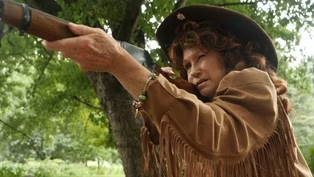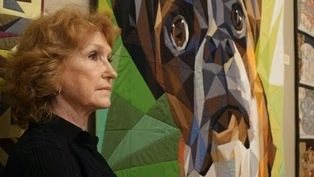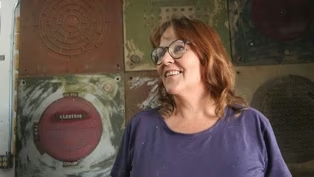
Carla Rodriguez
Clip: Season 15 Episode 7 | 11m 32sVideo has Closed Captions
Wet plate photographer Carla Rodriguez uses the nearly two century old tintype process.
Wet plate photographer Carla Rodriguez uses the nearly two century old tintype process to capture vivid portraits that will stand the test of time.
Problems playing video? | Closed Captioning Feedback
Problems playing video? | Closed Captioning Feedback
Postcards is a local public television program presented by Pioneer PBS
Production sponsorship is provided by contributions from the voters of Minnesota through a legislative appropriation from the Arts and Cultural Heritage Fund, Explore Alexandria Tourism, Shalom Hill Farm, Margaret A. Cargil Foundation, 96.7kram and viewers like you.

Carla Rodriguez
Clip: Season 15 Episode 7 | 11m 32sVideo has Closed Captions
Wet plate photographer Carla Rodriguez uses the nearly two century old tintype process to capture vivid portraits that will stand the test of time.
Problems playing video? | Closed Captioning Feedback
How to Watch Postcards
Postcards is available to stream on pbs.org and the free PBS App, available on iPhone, Apple TV, Android TV, Android smartphones, Amazon Fire TV, Amazon Fire Tablet, Roku, Samsung Smart TV, and Vizio.
Providing Support for PBS.org
Learn Moreabout PBS online sponsorship(gentle music) - There's a moment where the plate goes into the fix and it turns from a negative to a positive.
And I remember seeing the image kind of come through this fog and just being like, "Oh, this is what I'm doing now.
This is what I'd like to do."
(bright music) And I remember my teacher, expressing that to my teacher and her being like, "Good luck.
It's really expensive and the learning curve is steep."
And I was just like, "Challenge accepted, thanks."
(bright music) This stuff that I'm doing right now, like the silver nitrate, it's not like breathe bad, but it's like if getting my eyeball bad, so I should be wearing goggles.
Be safe kids.
Do as I say, not as I do.
Essentially, wet plate refers to the overarching process and then there's derivatives basically on what you're making it on.
So I'd make mostly tintypes, which means it's done on metal.
So in this case, for me, it would be aluminum.
You kind of create this skin on the plate, do like a little finesse with your hands and then put that while it's still wet into a silver nitrate bath, which is part of what makes it light sensitive.
So at this point, all these steps you can do kind of in the light, but once it goes into the silver nitrate bath is when it needs to be red light or darker.
Could your face a little bit more this way?
- Yeah.
- Ready, one, two.
Good job.
I shoot the image either with a tremendous amount of light or sunlight, which might be a longer exposure.
Take the plate back into the dark room, process it immediately.
A lot of people think it's development, but it's actually just the fix pulling out the unexposed silver from the plate so you can see the black ground and see the image essentially.
(chill music) Something that I think is really interesting now with digital photography or with our phones where a lot of those images that we make that are like documenting our lives, documenting the people around us are only living on our phones and we don't make things anymore and we don't print things.
And so, I wonder a lot about what that's gonna look like if those things get lost or when the apocalypse happens and all that's left, it's gonna be tintypes, let me tell you.
(chill music) There's this deep history of postmortem photography with wet plate.
A lot of times that's the only time people got photographed.
Yeah, so these are some of the postmortem images, so the children are dead in these images.
Yeah, they tried to pose them sometimes as if they were alive.
This is like a kind of like a hidden mother thing where there's somebody with a sheet over them holding the child up.
We have a totally different relationship with death now than we did then.
I think people were a lot more comfortable with it.
So it was okay for them to have the only picture of their loved one be of them after they're no longer in their body.
The desire to have documentation of your visage or like your family, that kind of thing, our memories are so unreliable, especially when somebody's gone.
I'm gonna get emotional, sorry.
It's like a lot of those pieces go away really fast, the sound of their voice, the way they smell, even sometimes the way that they looked.
And so, I think photography plays this really beautiful role where it's like we at least get to hang on to the shape of their face or the way their eyes looked and especially specifically in that moment.
I'm not a super history nerd or buff.
I'm actually kind of surprised I got so drawn into this process.
I think for me, it was more like the tactile nature of it and the chemical process of it.
But the history is super interesting and something also that I tried to... Not tried to, I have to speak to in my work, we don't see a lot of tintypes or wet plate images of Black and Brown folks.
Part of that is access, right?
And class.
People paid to have these images made and when you're a slave or oppressed, you don't really have a lot of access to those things.
There are some images of Black folk, but they're really rare.
It's like when you find a tintype like that, they can be really expensive because of the rarity.
I feel like it's part of my job and my responsibility as an artist working with this process to think about that, address that and try to like add to a new history that we're doing now with this process.
(bright music) So I grew up in Houston, Texas.
I'm a first generation American to Venezuelan immigrants.
My mother came from Maracaibo and then my father from Caracas.
And they both immigrated here, gosh, probably in the eighties, nineties.
(upbeat music) My mom was a beautician, but she was really creative.
She was really good at like floral arrangements and obviously like hair can be really creative and stuff too.
And then my dad was a personal trainer, but he was like an aspiring actor as well.
So they were both like really creative.
They're both like amazing dancers.
My dad loved to sing.
They're all like mixed up.
They're just like random pictures.
These are like some of my mom's clients.
I don't know, she really was like, "Oh, let me take pictures."
Look at this, this is so funny.
This is her coat and I don't know who these women are, but my mom took these pictures of these women in her coat, in her house for some reason being like, "Yeah, model this for me," or whatever.
(gentle music) So my mother was diagnosed with colon cancer kind of late stage and struggled with that really heavily for a year and then passed away in 2012.
And then, my father has always struggled with mental illness.
It was kind of acute for about a decade and then in 2016 he ended up taking his own life.
So I've unfortunately experienced a lot of loss early on.
I had really deep connections with both my parents, so it was really tough.
(gentle music) I think a lot about them when I make pictures.
So especially for families and I think a lot about being able to give somebody something like this that they can hang on to for a long time.
And if it's kind of bittersweet where I'm glad that I can do this for somebody else 'cause I didn't get to do it for myself.
(gentle music) I treasure the fact that my mother was this much of a documentarian or that she cared this much about images.
And it's like, knowing...
I don't know, it's kind of like...
Sorry.
Knowing that I was loved by them is really nice.
That's how I feel when I look at them.
I was like, "Oh, wow, she loved me so much."
She was just like...
There's just like so much evidence of that in every picture that I look at.
And so, it's really great.
♪ All my life ♪ ♪ I've prayed for you ♪ ♪ When I'm tired ♪ ♪ You follow through ♪ ♪ I can breathe ♪ ♪ Breathe ♪ I feel like my life, I've experienced a lot of instability and with wet plate, there's a lot of unpredictable chemical anomalies or that kind of thing that can happen due to like temperature or the way I've handled something or how old the chemistry is.
But being able to control something wild like that has helped me feel more stable in my life.
The human experience is having something and losing something.
At some point in our lives, whatever that looks like, we're gonna experience loss.
Photography speaks to a lot because it is capturing these specific moments in someone's life that you can look back on.
I know it's a testament to how time trudges on and things change and I think that's painful and beautiful at the same time.
♪ I'm not sure ♪ ♪ I can maintain ♪ ♪ Control ♪ ♪ Every little piece of you ♪ ♪ Hurts now twofold ♪ ♪ I'm supposed to ♪ ♪ Not want to at all ♪ ♪ But I do ♪ (bright music) - [Announcer] "Postcards" is made possible by the Minnesota Arts and Cultural Heritage Fund and the Citizens of Minnesota.
Additional support provided by Margaret A. Cargill Philanthropies, Mark and Margaret Yackel-Juleen on behalf of Shalom Hill Farms, a retreat and conference center in a prairie setting near Wyndham, Minnesota.
On the web at shalomhillfarm.org.
Alexandria Minnesota, a year-round destination with hundreds of lakes, trails and attractions for memorable vacations and events.
More information at explorealex.com.
The Lake Region Arts Council's Arts Calendar, an arts and cultural heritage funded digital calendar, showcasing upcoming art events and opportunities for artists in West Central Minnesota.
On the web at lrac4calendar.org.
Playing today's new music plus your favorite hits, 96.7 Kram, online at 967Kram.com.
(bright music)
Video has Closed Captions
Clip: S15 Ep7 | 9m 12s | Fabric Artist and Quilter Anna Johannsen likes seeing life from unusual perspectives. (9m 12s)
Wet Plate Photography, Quilter, Community Space
Preview: S15 Ep7 | 40s | Carla Rodriguez's wet plate photos; Anna Johannsen's 3D quilts; the Madison Mercantile. (40s)
Video has Closed Captions
Clip: S15 Ep7 | 9m 2s | Kris Shelstad, a US Military veteran, recognized a need in her community and create it. (9m 2s)
Providing Support for PBS.org
Learn Moreabout PBS online sponsorshipSupport for PBS provided by:
Postcards is a local public television program presented by Pioneer PBS
Production sponsorship is provided by contributions from the voters of Minnesota through a legislative appropriation from the Arts and Cultural Heritage Fund, Explore Alexandria Tourism, Shalom Hill Farm, Margaret A. Cargil Foundation, 96.7kram and viewers like you.
























